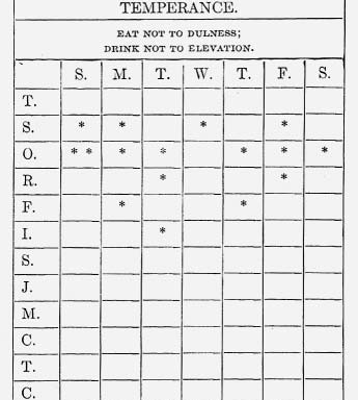A famous example of a moral accounting grid stems from Benjamin Franklin’s Art of Virtue. Franklin’s Art of Virtue relied on a tracking device that registers moral progress in terms of self-control. Franklin described his Art of Virtue in his autobiography (Franklin 2004), which was partly written in the form of a letter to his son, a book that is still part of the canon at American High Schools. It was published posthumously in 1791, first in a garbled French translation which became the source of many other translations.
The Autobiography tells the story of a successful life that pays little attention to Franklin’s role and involvement in the War of Independence, but much to his successes in business and his shifting attitudes towards religion. Franklin recounted how he started developing a self-help system for moral improvement in the same period he stopped attending church and he ascribed his major successes in life to this system, the Art of Virtue. He highlighted two characteristics of this system that he considered particularly important. First, he had designed a system of virtues that was general enough for a person of any religion to recognize its merit and usefulness. Second, he emphasized its practical usefulness to improve character, in contrast with a generic appeal to do good. It had struck Franklin how often habit or simple inattention had made virtue slip away. To counteract this tendency, he designed a mnemonic device to train himself more systematically in the cardinal virtues by tracking his moral record.
Finding himself confounded over the exact meaning of the cardinal virtues, he decided to extend their number, while limiting their meaning to a specific rule of action. He settled on thirteen virtues (after being prodded by a Quaker friend to include humility, which he admitted was not his forte). In his autobiography, Franklin refers to these virtues as character traits. Franklin reserved one page for each virtue in a small booklet which he accompanied with a short precept, or rule of action “which fully express’d the extent I gave to its meaning.” Temperance, for example, was explained with the precept “eat not to dullness, drink not to elevation.” Order was explained with “let all your things have their places; let each part of your business have its time.” On these pages, he drew a table that listed the days of the week horizontally and the thirteen virtues, including the one specifically under consideration, vertically. These virtues were listed in an order that would prepare his state of mind, or so he argued, more easily for the next one. Because Temperance produced “coolness and clearness of head,” it came first. Silence would then prepare him for Order, and so forth. He would then follow a fixed procedure to train him in these virtues. As he considered it would be impossible to concentrate on all virtues at once, he would start with the first, Temperance, leaving the others to their natural course, but marking any faults with a dot. In the example above, we see a clean slate for Temperance, but two dots for violating Silence on Sunday, indicating that he had engaged in “trifling” or useless conversation and thus had wasted his or someone else’s time. After having concentrated for a week on Temperance, he would move to the next virtue, Silence, trying to now keep two rows empty. He would then include the third, and so on. After having completed the full cycle, he would return to the first. The final goal was to end with an empty slate—no dots. After having used his little book for a while, Franklin inscribed the table on “the ivory leaves of a memorandum book,” drawing the table in permanent red ink, and adding the dots with a pencil that could easily be erased. After several years of regular practice, he diminished the number of cycles he practiced until his busy life of business and travel prevented him from attending to his Art of Virtue altogether.
Franklin’s moral tables enabled him to keep track of his moral progress in terms of self-control. Franklin’s tables were primarily centered on his individual performance. But Franklin was convinced that the strengthening of his fortune and well-being was due to “this little artifice” that he “with the blessing of God” had practiced for a substantial period of his life. Franklin considered that respecting Temperance had brought him his “long-continued” good health, Industry and Frugality, his early material fortune and a reputation as a “useful citizen,” Sincerity and Justice, the trust that was put into his political endeavors, and to all the other virtues his reputation as a socially agreeable person. The tables had served him to exercise restraint. They had made his moral progress visible to himself and had served as a check on his progress.
[1] Franklin’s complete list was as follows: temperance (“Eat not to dullness; drink not to elevation”); silence (“Speak not but what may benefit others or yourself; avoid trifling conversation”); order (“Let all your things have their places; let each part of your business have its time”); resolution (“Resolve to perform what you ought; perform without fail what you resolve”); frugality (“Make no expense but to do good to others or yourself; i.e., waste nothing”); industry (“Lose no time; be always employ’d in something useful; cut off all unnecessary actions”); sincerity (“Use no hurtful deceit; think innocently and justly, and, if you speak, speak accordingly”); justice (“Wrong none by doing injuries, or omitting the benefits that are your duty”); moderation (“Avoid extremes; forbear resenting injuries so much as you think they deserve”); cleanliness (“Tolerate no uncleanliness in body, cloaths, or habitation”); tranquility (“Be not disturbed at trifles, or at accidents common or unavoidable”); chastity (“Rarely use venery but for health or offspring, never to dullness, weakness, or the injury of your own or another’s peace or reputation”); and humility (“Imitate Jesus and Socrates”) (Franklin 2004: 68–69).

